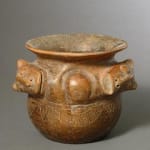Chorrera Terracotta Zoomorphic Effigy Vessel, 1100 BCE - 300 CE
Terracotta
5.25
PF.4241
Further images
The Pre-Columbian cultures of Ecuador are among the oldest in South America and among the first to master the art of pottery. Although we know little about the peoples themselves...
The Pre-Columbian cultures of Ecuador are among the oldest in South America and among the first to master the art of pottery. Although we know little about the peoples themselves or their traditions, historians have been able to piece together a picture of life in Ancient Ecuador thanks in part to the art and artifacts left behind. The culture of Valdivia created some of the oldest known works of art in the Americas. Situated along the coastal strip of Ecuador, the Valdivians established a thriving society that flourished for around two thousand years (from approximately 4000 to 1500 B.C.). Today they are famed for their small fertility figures, believed to be the earliest representational works of art in the Americas, first carved from stone, later formed from terracotta.
Hundreds of years later after the Valdivians disappear from the archaeological record appears another culture to which the name Chorrera has been attached (lasting from circa 1100-300 B.C.). Little is known about this culture; however, it is significant for its widespread geographical reach. As such, their artistic style greatly influenced those diverse cultures that began to emerge in the final centuries of the Chorrera period, a time historians have labeled the Period of Regional Development.
This charming effigy vessel has two animal-like heads lying horizontally across the mid-section of the vessel. Upright ears and large button-like eyes create a gentle, inviting expression on their faces. There is an interesting difference between the two mouths. One mouth appears to be smiling while the other is open for howling. Certainly this vessel is rich with mythical symbolism. Crafts, such as pottery making, were specialized activities associated with religious practices that expressed complex symbolism. Two long, tail-like projections protrude forth on the back of the vessel. Linear and circular incisions are displayed below the heads and within the inside of the wide rim. Incarnated with cosmic forces that governed the physical world, this magical vessel lures our imaginations to ancient realms of reality.
Hundreds of years later after the Valdivians disappear from the archaeological record appears another culture to which the name Chorrera has been attached (lasting from circa 1100-300 B.C.). Little is known about this culture; however, it is significant for its widespread geographical reach. As such, their artistic style greatly influenced those diverse cultures that began to emerge in the final centuries of the Chorrera period, a time historians have labeled the Period of Regional Development.
This charming effigy vessel has two animal-like heads lying horizontally across the mid-section of the vessel. Upright ears and large button-like eyes create a gentle, inviting expression on their faces. There is an interesting difference between the two mouths. One mouth appears to be smiling while the other is open for howling. Certainly this vessel is rich with mythical symbolism. Crafts, such as pottery making, were specialized activities associated with religious practices that expressed complex symbolism. Two long, tail-like projections protrude forth on the back of the vessel. Linear and circular incisions are displayed below the heads and within the inside of the wide rim. Incarnated with cosmic forces that governed the physical world, this magical vessel lures our imaginations to ancient realms of reality.







